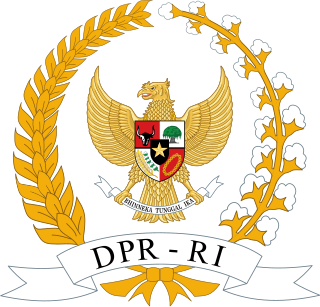
The House of Representatives of the Republic of Indonesia is one of two elected chambers of the People's Consultative Assembly (MPR), the national legislature of Indonesia. It is considered the lower house, while the Regional Representative Council (DPD) serve as the upper house; while the Indonesian constitution does not explicitly mention the divide, the DPR enjoys more power, privilege, and prestige compared to the DPD.

The People's Consultative Assembly of the Republic of Indonesia is the legislative branch in Indonesia's political system. It is composed of the members of the House of Representatives (DPR) and the Regional Representative Council (DPD). Before 2004, and the amendments to the 1945 Constitution, the MPR was the highest governing body in Indonesia.

The Central Indonesian National Committee, also known as the Central National Committee, was a body appointed to assist the president of the newly independent Indonesia. Originally purely advisory, it later gained assumed legislative functions. The Working Committee of the KNIP became part of the People's Representative Council when Indonesia became a unitary state in 1950.

The Speaker of the House of Representatives, is the presiding officer of the House of Representatives of Indonesia. The speaker is the political and parliamentary leader of the House of Representatives and is simultaneously the Council's presiding officer. The speakers also perform various other administrative and procedural functions.

The House of Representatives of the United States of Indonesia was one of the two national legislative assemblies in the United States of Indonesia (RUSI). The council was formed after the establishment of the Indonesian federal state, consisting of 150 members.

Arudji Kartawinata was an Indonesian politician and military officer. During the Indonesian National Revolution, he was the first commander of the 3rd Division, predecessor to the modern Siliwangi Division. Politically, he was initially a member of Masyumi before later re-forming the Indonesian Islamic Union Party. He served as the chairman of the People's Representative Council for three years between 1963 and 1966.

Sartono was an Indonesian politician and lawyer who served as the first speaker of the People's Representative Council (DPR) from 1950 until 1960. Born to a noble ethnic-Javanese family, Sartono studied law at Leiden University. During his studies, he joined the Perhimpoenan Indonesia association and became an advocate for Indonesian independence. After graduating, he opened a law practice and helped found the Indonesian National Party (PNI) in 1927. When several party leaders were arrested by the colonial government in 1929, he became one of their defense lawyers and unsuccessfully argued for their acquittal. Following the arrest of its leaders, PNI became paralyzed and the party subsequently suspended its activities. In its place, Sartono founded a new political party, Partindo, which sought to achieve independence through non-cooperation and mass action. Partindo lasted until 1936, when it decided to dissolve itself. After Partindo's dissolution, Sartono helped found another party, Gerindo, which advocated for the creation of an Indonesian parliament.

The Senate of the United States of Indonesia was the upper chamber of the Parliament of the United States of Indonesia which, along with the People's Representative Council—the lower chamber — comprised the legislature of the United States of Indonesia.

Tadjuddin Noor was an Indonesian politician and nationalist. He was a deputy speaker of the Provisional People's Representative Council between 1950 and 1956, and chaired the legislature of the State of East Indonesia (NIT).

Melkias Agustinus Pellaupessy was an Indonesian politician born in Ambon, Dutch East Indies on 15 May 1906.

Antoinette Wailan Weënas, better known by her birth name Antoinette Wailan Waroh, was an Indonesian politician who became the only female parliament member in the Provisional Representative Body of East Indonesia.

Wiluyo Puspoyudo was an Indonesian military figure and politician who became the deputy speaker of the People's Consultative Assembly from 1960 until 1966, and as the acting Speaker of the People's Consultative Assembly in 1966.

Paula Bataona Renyaan was an Indonesian police general and politician. She was the first woman to hold the office of Vice Governor in Indonesia, serving as the Vice Governor of Maluku from 1998 to 2003.

Djerman Prawirawinata was a Sundanese politician who served as the last Minister of State of Pasundan and a member of the People's Representative Council.





















